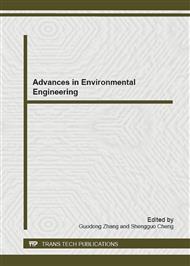p.395
p.400
p.404
p.412
p.418
p.428
p.434
p.441
p.448
Analysis on Water Pollution Characteristics of Typical Urban River-Taking the Zaohe River in Xi′an City as an Example
Abstract:
Zaohe River is a main pollution and flood discharge river in Xian city. Its water quality is affected not only by the point source pollution (PSP), but also by the non-point source pollution (NSP) to some extent. Water flow and water quality of Zaohe River are monitored during the flooding and non-flooding periods from April in 2010 to October in 2011. The results indicated that: 1) The concentration of COD, TP, NH3-N, and TN are exceed the Environmental quality standard grand Ⅴ for surface water (GB3838-2002 of China). 2) The concentration of COD is increasing from upstream to downstream. The concentration of TP, NH3-N, and TN increase firstly and then decrease. The change of NO3-N is small and the concentration of Cr is the lowest in the heavy metal pollutants. 3) The variations of pollutant concentration are smaller during the non-flooding periods than the flooding periods at Caotan section. The NSP load is lower than PSP in the flood period, and the NSP load ratio of SS, COD, NH3-N, NO3-N, TN, DP and TP is 14%, 2.0%, 5.1%, 6.0%, 7.4% and 4.2% separately. 4) The PSP plays the important role in the pollution abatement of Zaohe River,but the NSP can not be ignored, too.
Info:
Periodical:
Pages:
418-427
Citation:
Online since:
November 2012
Authors:
Price:
Сopyright:
© 2012 Trans Tech Publications Ltd. All Rights Reserved
Share:
Citation:


